|
GETAC A790
A fully rugged notebook that can even accommodate PCI or PCI-Express expansion cards
(by Conrad H. Blickenstorfer -- view PDF version)
This is a review of the GETAC A790 fully rugged notebook computer, a machine specifically built to provide maximum performance and utility under the harshest possible environmental condition. Also, right upfront, if you wonder why the system unit part of the machine shown in the picture below is so thick, that is because it is one of the very few notebooks that can handle two 3/4-length desktop-style PCI cards in an optional PCI Expansion Unit that's bolted onto the bottom of the notebook. 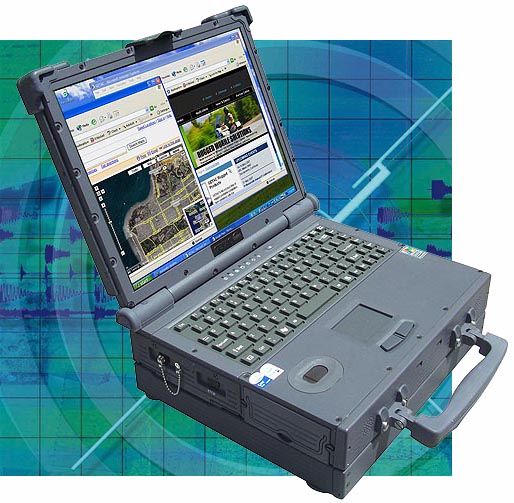 The machine shown in this picture has the PCI expansion unit installed. Why is this important? Because while today's notebooks come fully equipped, some functionality is only available via standard PCI expansion cards, and if an application requires that functionality, the GETAC A790 is one of the very few state-of-the-art rugged notebooks that can deliver. And not just PCI cards. GETAC has expansion units for older legacy ISA cards and the new PCI Express cards also. The machine shown in this picture has the PCI expansion unit installed. Why is this important? Because while today's notebooks come fully equipped, some functionality is only available via standard PCI expansion cards, and if an application requires that functionality, the GETAC A790 is one of the very few state-of-the-art rugged notebooks that can deliver. And not just PCI cards. GETAC has expansion units for older legacy ISA cards and the new PCI Express cards also.
Existing and potential GETAC customers are likely familiar with the company background and so I'll only state the basics: General Electric-Aerospace and Mitac Group of Taiwan founded GETAC back in 1989. Ever since, GETAC has been at the very forefront of ruggedized mobile and portable innovation for military and other demanding markets worldwide.
By now, the company is closing in on 20 years of experience in building water-tight enclosures, thermally efficient no-vent equipment, resistance to shock and vibration, accommodating operation in very wide temperature ranges, and whatever else it takes to building computers that can handle dust, sand, snow, water, hazardous materials and other environmental conditions.
The A790 benefits from all this experience. It also benefits from the numerous man-years of testing and using the platform in military, industrial, and extreme commercial applications. That's because the A790 is the latest version of a field-proven, reliable platform that builds upon the success of the GETAC A770, A760, and going all the way back to the A740 running on a Pentium 200MMX chip. From a design standpoint, this machine has been a success from its inception. And GETAC made sure it kept the technology of the A-Series up-to-date.
What do you get with the GETAC A790?
The A790 is machine that packs all modern notebook computer technology and connectivity into an exceptionally tough box. It is nearly indestructible, yet offers more expansion possibilities and more customization flexibility than almost anything else on the market.
In terms of technology, this latest A-Series model comes with a 1.66GHz Intel Core Duo L2400 processor. This chip uses what Intel calls "dynamic power coordination," dynamic cache sizing, and the ability to go into deep sleep so that power is used only in those areas of the CPU that need it. This represents an excellent compromise between robust processing power and improved battery life. The A790 uses DDR2 memory. It comes standard with 512MB and can be expanded, via two slots, to a total of 2GB. The primary hard disk is an IDE/SATA 80GB drive; larger units up to 120GB are available. The disk is housed in its own bay in a self-contained removable caddy with extensive shock absorption (see small picture below).
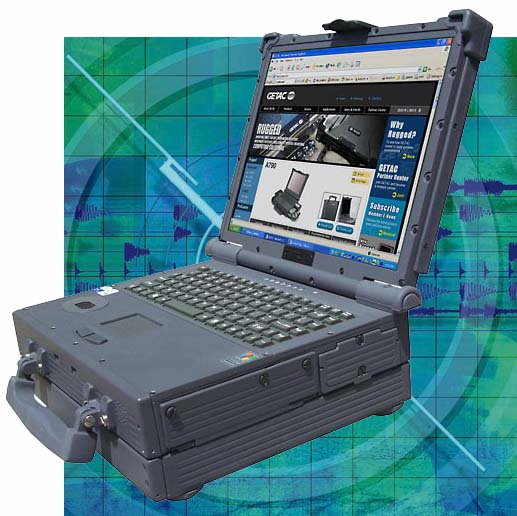 On the display side you have your choice between a 12.1 and a 14.1-inch LCD, both with 1024 x 768 pixel XGA resolution. The smaller 12.1-inch screen is available with an optional touch screen, and GETAC also offers a sunlight-readable screen option. The screen hinge is very sturdy, and the LCD casing locks onto the main body of the computer with a large metal latch. Push the LCD lid down firmly, then push on the latch to lock it. Simply pull on the bottom of the latch to release it. On the display side you have your choice between a 12.1 and a 14.1-inch LCD, both with 1024 x 768 pixel XGA resolution. The smaller 12.1-inch screen is available with an optional touch screen, and GETAC also offers a sunlight-readable screen option. The screen hinge is very sturdy, and the LCD casing locks onto the main body of the computer with a large metal latch. Push the LCD lid down firmly, then push on the latch to lock it. Simply pull on the bottom of the latch to release it.
The waterproof and dustproof rubber keyboard is visible proof that this is a machine designed to be used under adverse conditions where dust or sand or rain are facts of life. What this means is that the keyboard has a rubber overlay with molded keys. That makes it 100% waterproof, but also takes some getting used to. There is tactile feedback, but it is very different from a standard keyboard, and the keys require a firm push rather than the typical touch-typist tap. The QWERTY layout is also very slightly smaller, 96% instead of full scale. 100% scale would have been preferable and possible, but the difference is hardly noticeable.
As far as size goes, the A790 is actually rather compact. The footprint of the 14.1-inch screen version is 12.5 x 10.8 inches, including protective rubber bumpers, and the machine is 2.7 inches thick without the bumper, and 3.25 with it. The PCI card expansion unit adds about two inches, including rubber feet and bumpers. It's not a lightweight. Our review unit with the PCI card expansion weighed in at 16.4 pounds; without the expansion it's maybe 13 pounds, depending on media bay options.
The overall design of the A790 can best be described as purposeful. Below is a picture of the backside of the A790, mounted on top of the PCI expansion unit. The chassis and housing are all very thick and sturdy, precision-machined aluminum alloy. All hinges are metal; nothing feels flimsy. There are no swoops and curves or design elements other than a few grooves and raised lines here and there.
Thick rubber moldings and bumpers protect exposed corners and edges simply and sensibly. Internal bays and slots are sealed via thick metal doors with O-ring rubber seals and additional foam padding. They are secured via large screws that can be opened and tightened with a screwdriver or even a penny. They cannot fall out and will therefore not get lost. Smaller ports are all individually sealed with soft rubber plugs. They have flaps at the bottom so you can easily grab them and open them. Should one break or rip off, it can individually be replaced.
As for color, it's all flat gunmetal gray, both metal and rubber. The only thing that shines is the "GETAC" logo on the plastic badge sitting in a recess on top of the computer.
You can see the handle on the picture on top of the page. It's a precision-crafted, industrial aluminum/rubber affair that's ergonomically correct without taking up much space. Nothing fancy here; it's for carrying the computer after all. It's secured with four screws. If you don't need the handle, just take it off and stow it away.
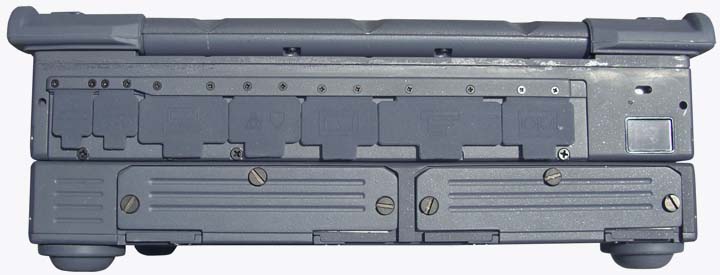
Expandability and customization is what this machine is all about, so let's look at all the ports and interfaces. On the picture above, along the back, are:
- Power
- Two USB 2.0 connectors
- Docking connector
- RJ45 LAN port and RJ11 modem port
- External video
- Legacy parallel port
- Legacy serial port
- Infrared
The two doors on the bottom provide access to installed PCI cards.
Left side: Massive battery and X Bay for wireless options
Below you can see the left side of the GETAC A790. The door with the handle on the right side tightly seals the battery compartment that contains a beefy 106.5 watt-hour (11.1V, 9600mAh) Lithium-Ion Smart battery pack. 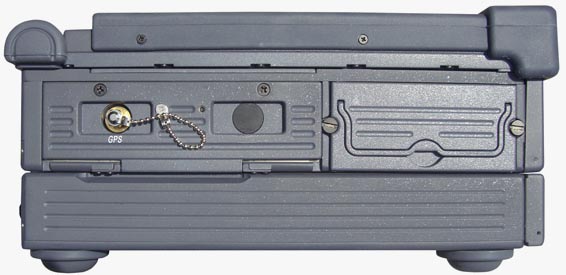 The door on the left, secured by two small Phillips screws, protects the "X Bay," the home of a variety of installable radio and other wireless options.
The door on the left, secured by two small Phillips screws, protects the "X Bay," the home of a variety of installable radio and other wireless options.
Behind the door you even find a standard SIM card slot so you can use the GETAC A790 with GSM/GPRS/EDGE voice and data services with the wireless carrier of your choice. The little chain on the left secures the cap on the external antenna port of the A790's GPS receiver. On this view, also note the very practical (and easily replaceable) thick rubber bumpers and moldings that provide extra protection to an already very rugged computer.
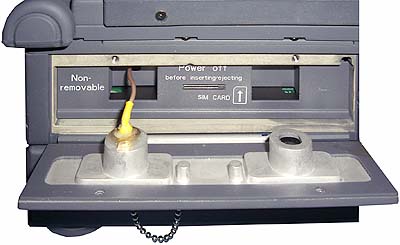 On the picture to the left you can see the external connector to a freestanding high-performance 2-inch diameter puck-style GPS antenna (not shown). It comes with an 11-foot antenna cable that is long enough to allow good GPS reception in the computer even in difficult locations. You'll always find a place for optimal satellite signal reception. On the picture to the left you can see the external connector to a freestanding high-performance 2-inch diameter puck-style GPS antenna (not shown). It comes with an 11-foot antenna cable that is long enough to allow good GPS reception in the computer even in difficult locations. You'll always find a place for optimal satellite signal reception.
The A790's XBay is supremely configurable. Instead of the GPS/SIM Card option (which also includes a Bluetooth PAN radio) in the review machine we had in our lab for testing, it might contain a Smart Card reader, a second PC Card slot, a second floppy drive, Bluetooth, an Ultra320 SCSI controller, and RS232/422 port or a 3G Wireless module that supports HSDPA/UMTS@2100MHz, EDGE/GPRS @ 850,900,1800,1900MHz and CDMA 1X-EVDO (which is backward compatible with CDMA, CDMA200 1XRTT).
Right side: Protected hard disk and flexible Media Bay
Two more sealed doors are located along the right side of the GETAC A790. Both doors are secured with large screws that can be opened with a penny or an instrument. Both are sealed and totally waterproof.
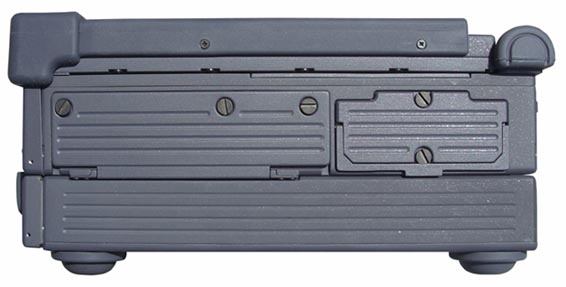 The right one covers the hard disk compartment with its slide-out caddy and prodigious amounts of shock absorption to keep the disk from getting damaged.
The right one covers the hard disk compartment with its slide-out caddy and prodigious amounts of shock absorption to keep the disk from getting damaged.
The left one reveals the Media Bay, so named because it may contain a floppy drive (as shown below), but also a DVD dual drive, a CDRW/DVD combo drive, a second hard drive with a capacity of up to 120GB, or a second battery. Should you choose the second battery as the occupant of the Media Bay, it is not a wimpy one either: if power is what you need most, the Media Bay's second battery adds another 70 watt-hours. That is more than most laptops' primary battery and greatly expands the A790's battery life. This is an option attractive for situations that require full-shift operation.
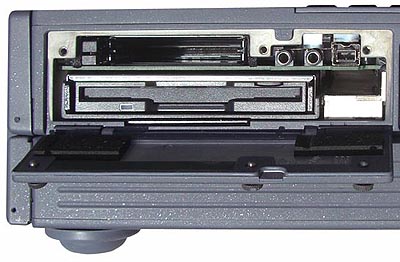 Above that sits a PC Card slot that can handle either two Type II cards or one of the thicker Type III variety. To the right of it are the microphone and speaker jacks, and to the right of them a 1394B FireWire port.
Above that sits a PC Card slot that can handle either two Type II cards or one of the thicker Type III variety. To the right of it are the microphone and speaker jacks, and to the right of them a 1394B FireWire port.
The Media Bay certainly provides a lot of options, but it always makes me a bit nervous to see so much electronics exposed all at once. So make triple-sure you properly screw down the sealer door after every time you open it to plug in a microphone or a FireWire device. I'd prefer to see the audio and IEEE1394 jacks have separate rubber plugs. Another potential issue is that using the optical drive may force you to leave the sealer door open. Not good while outside and in the rain.
The PCI Expansion Unit
The PCI (Peripheral Component Interconnect) Expansion Unit makes the A790 special and sets it apart from almost any other notebook out there. There are a few that can accommodate standard PCI cards, but they are generally much larger and bulkier than GETAC's elegant solution. The expansion unit is essentially a second-gen PCI-to-PCI bridge fully compliant with the PCI Local Bus 2.1 specifications. The picture below right shows a look into the A790's expansion bay, with the bottom panel removed.
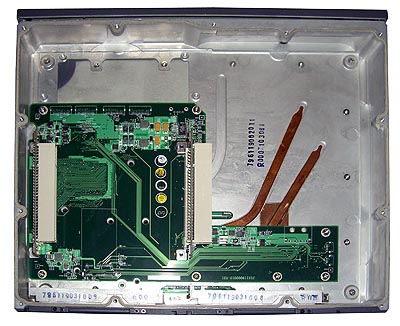 There are some limitations. Full size PCI cards are 12.3 inches long and 4.2 inches tall, and simply wouldn't fit into the footprint of the A790. As is, the Expansion Unit can accommodate cards up to 8.3 inches long. An additional constraint is that the card in one of the two slots cannot be taller than 4 inches. Half-length cards (usually 6.9 inches long) and most 3/4-size cards fit just fine. Keep in mind that PCI 2.1 does not support ATA66, and you can't draw more than 10 watts per slot. This may or may not be a limitation. Do make sure that whatever cards you have in mind fit into the allocated space, and also that they do not exceed PCI Rev. 2.1 requirements. There are some limitations. Full size PCI cards are 12.3 inches long and 4.2 inches tall, and simply wouldn't fit into the footprint of the A790. As is, the Expansion Unit can accommodate cards up to 8.3 inches long. An additional constraint is that the card in one of the two slots cannot be taller than 4 inches. Half-length cards (usually 6.9 inches long) and most 3/4-size cards fit just fine. Keep in mind that PCI 2.1 does not support ATA66, and you can't draw more than 10 watts per slot. This may or may not be a limitation. Do make sure that whatever cards you have in mind fit into the allocated space, and also that they do not exceed PCI Rev. 2.1 requirements.
However, even if a card appears not to meet the requirements, GETAC may have a solution anyway. The company works with many integrators to accommodate larger-size PCI cards as well as some very special user-specific modules in customizing the A790 Expansion Unit. And GETAC's ProCustom team is actually able to accommodate just about any special need, including military connectors, docking bay modifications, MIL-STD interfaces, and so on. See the GETAC website for some compelling examples.
In order to insert cards, you undo 13 Phillips screws and remove the bottom. Inside you will find the PCI Bus circuit board with its connectors. It is a complex, elegant arrangement, and it clearly shows that the GETAC engineers put a lot of thinking into making this expansion possible. Adding the Expansion Unit does not impact the A790's environmental sealing. The bottom cover has a full O-ring and seals tight. The kit also comes with replacement rubber feet with integrated bumpers. Those can (but don't have to be) be used to add additional protection. As always when you work with small Phillips screws, make sure to use a sharp, hard quality screwdriver of exactly the right size. No need to mess up the screws.
PCI, of course, is not the only bus type used. For that reason, GETAC also offers an ISA Expansion Unit for older legacy cards, and a PCI-Express Expansion Unit for the much faster PCI Express standard that was introduced in 2004.
Security
Almost all new and updated notebooks have beefed up security features, and the A790 is no exception. To the left of the touchpad, below the keyboard, is a built-in Biometric Fingerprint Reader. The machine also has a TPM (Trusted Platform Module) 1.2 chip. TPM provides encryption capability and can be used to authenticate hardware devices. Add the Smart Card reader and the security software GETAC included, and the machine will be as secure as Fort Knox.
Ruggedness
The term "rugged" is descriptive rather than specifically defined. However, we know one when we see one, and the A790 quite obviously is a "rugged" machine. And unlike the vague terminology, ruggedness testing procedures are very well defined and executed in what I call "torture chambers." GETAC tested the A790 for tolerance to temperature, humidity, altitude, shock, drop, vibration, ESD exposure, and a few others. All these tests are performed to standards described by regulatory agencies, most using MIL-STD or IEC procedures. Enclosure protection, or Ingress Protection, is at the IP54 level. The "5" means the A790's enclosure is protected against particles as fine as dust; the "4" means it is protected against water sprayed at it from all directions. A standard A790 can operate in temperatures between 32 and 131 degrees Fahrenheit. A special low-temperature option expands that to -4 to 131 degrees.
GETAC offers a vehicle dock for the A790. It essentially replicates the ports, but also adds a second serial interface as well as BNC video capture. GETAC offers environmental specs for the dock as well, and even crash tested it. Those guys take ruggedness and protection serious.
Summary
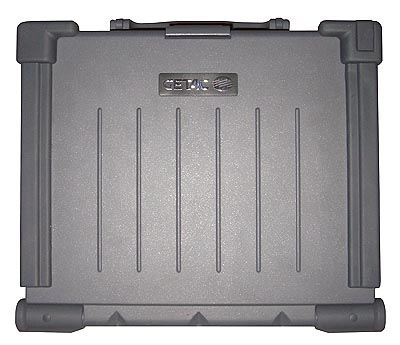 With the A790, GETAC offers a rugged notebook computer that is unique insofar as you can add ISA, PCI and even PCI-Express cards via an optional expansion unit. None of the primary competition has that.
With the A790, GETAC offers a rugged notebook computer that is unique insofar as you can add ISA, PCI and even PCI-Express cards via an optional expansion unit. None of the primary competition has that.
This is a tried and field-proven machine that technologically builds on several generations of predecessors that have been seeing duty under adverse conditions all over the world. The A790 represents a substantial technology update in processor performance and efficiency. It also provides the latest wireless options. Yes, you can even use a standard SIM card in the A790.
Like all GETAC units, the A790 features exemplary thermal design that makes it a cool-running, silent computer. Instead of a fan, GETAC uses heat pipes and the thick aluminum alloy case itself to keep the computer cool.
Another GETAC tradition is to equip its machines with a wealth of communication and interface options, and the A790 is no exception. From legacy serial and parallel ports all the way to USB 2.0, IEEE1394 and advanced 3G wireless and GPS options, it's all there, and almost all ports are individually sealed for extra protection.
All in all, this is a rugged computer whose basic design has a long history of reliable operation under adverse conditions. The technological updates make it pretty much state-of-the-art. There is plenty of onboard connectivity, massive battery power, a long list of wireless and other options. And then there are the ISA/PCI/PCI-Express Expansion Units that none of the direct competitors can offer. All of this makes the GETAC A790 a very compelling choice.
GETAC A790 highlights:
- Full size, rugged computer with up-to-date technology
- Massive battery power (well over 200 watt-hours) via main and two auxiliary batteries
- Extensive onboard connectivity, including advanced optical drives
- Availability of ISA, PCI, PCI Express expansion units
- Availability of all current and advanced wireless options
- Beefed-up security with fingerprint reader and TPM chip
- No fan = virtually silent operation
But keep in mind:
- Fairly large and heavy, especially with expansion unit
- Rubber keyboard takes getting used to
- Touch screen option only on smaller 12.1-inch screen
– Conrad H. Blickenstorfer
GETAC A790 Specs
| Added/changed |
Added 5/05/2007
|
| Type |
Rugged notebook
|
| Processor |
Intel Core Duo L2400 1.66GHz, 667MHz FSB |
| OS |
Windows XP Professional |
| Graphics Controller |
Intel GMA950 |
| Memory |
512MB 533/667MHz DDR2 SO-DIMM expandable to 2GB (2 slots) |
| Display |
12.1 or 14.1" XGA (1024 x 768) TFT. Optional: touchscreen (12.1" only) and sunlight-readable display |
| Digitizer/Pens |
Optional touchscreen/1 |
| Keyboard |
87-key, 97%-scale, waterproof membrane keyboard; optional waterproof LED back-lit rubber keyboard |
| Storage |
80 - 160GB SATA |
| Media Bay |
Options: FDD; DVD Dual; 2nd battery; 2nd 80/120GB IDE hard disk |
| X Bay |
May include: RS232/422, Ultra320 SCSI, 2nd PCMCIA (Type II x 2 or Type III x 1), 2nd FDD, Smart card reader, Bluetooth (v2.0 class 2), GPS (with mouse type antenna); CDMA, CDMA2000, CDMA2000 1XRTT; GSM/GPRS@850,900,1800,1900MHz, WCDMA, HSDPA/UMTS@2100MHZ, EDGE and CDMA 1X-EVDO (backward compatible with CDMA, CDMA2000 1XRTT) |
| Slots |
2 PC Card Type II or 1 Type III |
| Housing |
Full magnesium alloy case |
| Temperature |
32 to 131 degrees Fahrenheit; -4 to 131 low temp option |
| Humidity |
45% to 95% RH, non-condensing |
| Vibration |
According to IEC 68-2-6 / MIL-STD-810F, Method 514.5 |
| ESD |
According to IEC1000-4-2 |
| Enclosure Class |
IP54 |
| Size |
13.1 x 11.1 x 3.4" (14.1" model); 13.1 x 10.5 x 3.4" (12.1" model) |
| Weight |
12.6 lbs. (12.1" model); 13.0 lbs. (14.1" model) |
| Power |
115.4 watt-hour Li-Ion Smart battery (11.1V, 10400mAh, can be rated to operation at -4F), Optional Media Bay 2nd 77 watt-hour Li-Ion battery (14.8V, 5200mAh), Optional X Bay 3rd Li-Ion battery (5200mAh) |
| Communication |
Intel PRO/Wireless 3945ABG; Optional: Bluetooth, GPS, CDMA/CDMA2000, CDMA2000 1XRTT, CDMA 1xEV-DO, GSM/GPRS/EDGE, HSDPA/UMT@2100MHz |
| Interface |
Serial, 2 USB 2.0, External VGA, 1394B, Parallel, RJ-45, RJ-11, Microphone, Line out, IrDA, Docking port, DC in. Also ISA/PCI/PCI Express cards via expansion unit |
Price |
Inquire |
| Contact |
GETAC us.getac.com |
|












